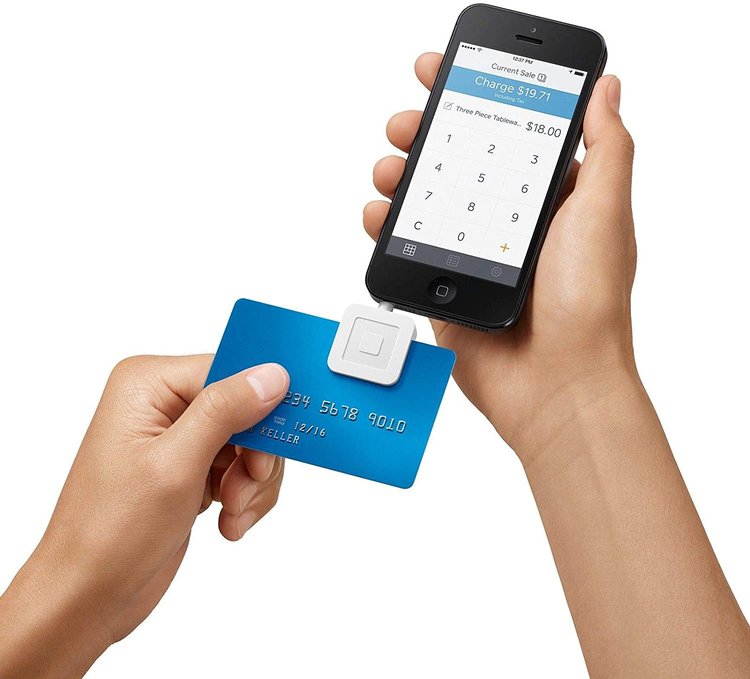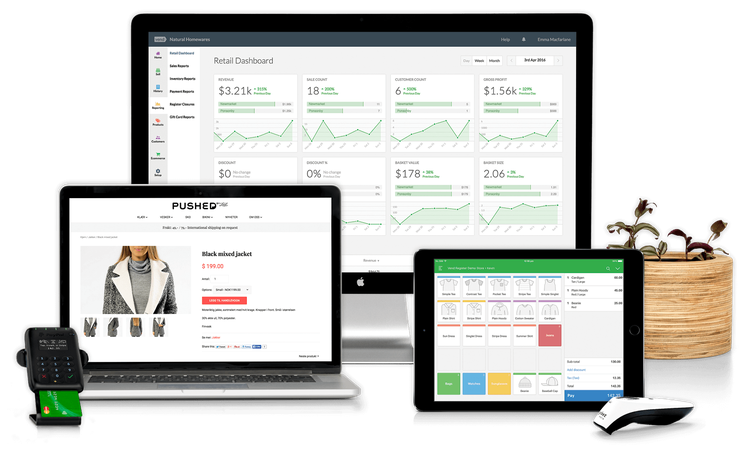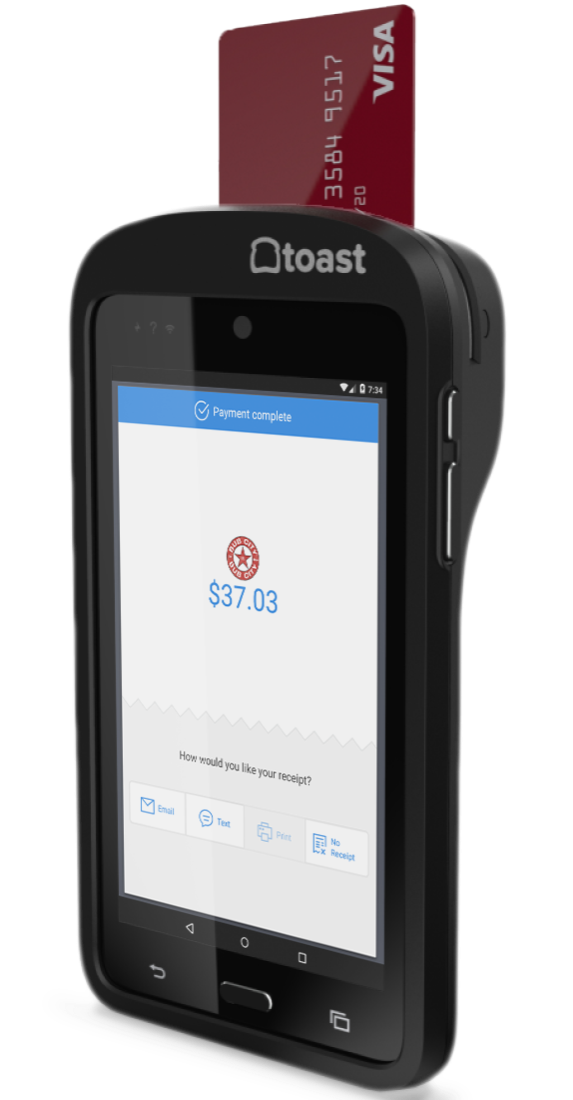I'm old enough to remember when business transactions were cash-only affairs. Even asking if checks were accepted earned you a sideway glance and a request to see some identification.
Since the advent of credit and debit cards and point of sale (POS) systems, though, cash and checks -- like the 8-track tape player in my first car -- are so last millennium.
Now it's POS terminals in fixed locations that are behind the times. Businesses must expand transaction opportunities beyond brick-and-mortar stores to stay competitive, and customers want to make purchases anytime and anywhere without having to look for an ATM to withdraw cash.
A mobile point of sale (mPOS) system addresses both these issues. We'll go over mPOS basics and how to set up an mPOS system, so you can see the benefits for your small business.
Overview: What is a mobile point of sale (mPOS) system?
Mobile point of sale systems allow you to accept payments via tablets, smartphones, and other handheld devices without being tied to a POS register in a single location. These transactions include credit card magstripe reader payments and wireless transactions.
mPOS transaction technology includes:
- Magnetic stripe reader (MSR): A handheld reader or hardware that plugs into a digital device reads a swiped credit card's magstripe.
- Europay, Mastercard, and Visa (EMV): The credit card is inserted into a card reader that accesses a chip embedded in the card instead of the magstripe.
- Near-field communication (NFC): Uses a smartphone's wallet feature to complete transactions with a nearby NFC device.
- Magnetic secure transmission (MST): When a customer holds their phone against a POS terminal, the phone emits a signal that emulates a credit card's magstripe.
- Quick response (QR) code: A customer scans a merchant QR code to make a payment, or the merchant scans a customer's QR code to access payment information.
Square made mobile payments possible without expensive handheld devices in 2009 when it introduced its first magstripe card reader that plugged into smartphones. Square gave the card readers away for free and charged a small fee for each transaction with no monthly plans or subscription costs.

Square's credit card reader remains a viable mPOS option for businesses with few off-site sales. Image source: Author
The best POS systems typically offer a range of mPOS options, but check the transaction fees, because they can differ from POS rates.
mPOS vs. POS: What's the difference?
The primary distinction between POS and mPOS systems is their hardware. A typical retail POS system operates in a fixed location and uses a mounted touch screen terminal, a cash drawer, and receipt printer.
mPOS devices are portable and allow you to move among multiple locations -- for instance, between 75 tables in a large restaurant.
POS and mPOS systems run the same software, which allows you to conduct transactions and access other features across a suite of hardware devices.

POS and mPOS hardware includes mounted terminals, tablets, laptops, barcode scanners, and handheld card readers. Image source: Author
Some portable POS software, such as Square's, can be installed on third-party devices. Other providers, including Toast, require you to buy their proprietary POS hardware.
What to consider when choosing a mPOS for your business
While an mPOS system processes transactions like a standard POS terminal, you need to consider which options you need and get the mPOS system that meets your requirements.
Features
Some mPOS systems offer a limited set of POS features, so double check that key functionality is available when you're on the go. The last thing you need are delayed or failed transactions because you expected your mPOS to mirror your POS system.
Things to check for include:
- Inventory management: Most POS systems include automated inventory management, but mPOS applications often lack this feature. Accurate inventory counts are essential, especially if you have ongoing mPOS transactions.
- Discounts: Applying discounts on the fly at flash sales or pop-up events keeps things running smoothly without resorting to a calculator to figure out transaction totals.
- Card-not-present (NPC) transactions: A virtual terminal allows you to manually key in card information on a digital device for purchases. These transactions are most common for telephone sales, but this feature is critical whenever you have a credit card that won't scan.
- Employee accounts: Separate employee accounts allow you to identify the source of transaction errors. You can also set account permissions to prevent employees from accessing all of the features and information on your mPOS system.

Use your mPOS to check sales, inventory, and other information when you're not at your primary brick-and-mortar location. Image source: Author
Some upfront research based on your industry and specific needs will help you find the best mPOS system for your small business.
Security
mPOS sales accounted for 4% of transactions in 2016 but are projected to exceed 20% by 2021.
Data protection is paramount as mPOS devices may not have security protocols as robust as their POS counterparts, especially if you're using commercial-off-the-shelf (COTS) devices such as Apple or Android smartphones and tablets.
Ensure your mPOS software is Payment Card Industry Data Security Standard (PCI DSS) compliant to protect customer information, which you may have to pay extra for. You also need to employ one or more of these security features:
- Encryption: End-to-end (E2E) encryption encodes data using a "key," which only the sender and bank processing the transaction have. Even if the data is intercepted, it can't be accessed without the encryption key.
- Tokenization: A merchant never accesses a card or bank account number; instead, payment is processed using a "token" -- a string of random numbers that substitute for the account number -- and account information is stored in a secure token vault.
- Dynamic authentication: Credit cards with EMV technology contain an embedded chip with customer information. This is more secure than magstripe transactions that can use data skimmed from a consumer's credit card.
mPOS transactions can provide more security than standard POS sales. Toast's handheld mPOS device for table-side ordering allows customers to pay at the table. This prevents their credit cards from vanishing into the restaurant and traveling through multiple hands to pay for a meal.

Toast's proprietary table-side ordering device allows customers to see their credit cards during the entire transaction. Image source: Author
Toast's table-side ordering features also allow orders to be transmitted immediately to the kitchen to increase delivery speed and decrease the odds of order mistakes.
How to set up a mobile point of sale (mPOS) system
Whether you select an mPOS system you set up yourself or one that requires vendor installation, schedule time to become familiar with its hardware and software, adding inventory or creating menus, and training employees to use it.
Step 1: Identify your needs
mPOS systems are not a one-size-fits-all solution. To find the best system for your small business, identify your current needs to choose the solution that works for you now and will scale up as your business grows.
Two considerations include:
- Industry: While you can tailor a generic mPOS to meet your needs, some systems are designed out of the box for different industries such as retail, restaurants, bars, consumer services, and hospitality.
- Sales volume: Your system choice also depends on your projected sales volume. The requirements for table-side ordering if you own three restaurants differ from having a single food truck expanding its payment options from cash only.
Carefully consider where your business is currently and what your future plans are to avoid buyer’s remorse.
Step 2: Choose an mPOS provider
If you're already using a POS system, check out its mPOS options. If it doesn't have any or none that meet your needs, consider changing your POS provider instead of running a parallel mPOS system.
Other factors to consider include:
- Fees: Mobile POS terminal transactions can have their own fee schedule -- a flat cost and percentage of each sale -- separate from your POS system. You may have an additional monthly subscription cost and pay more for add-on data security features. Integrations to expand functionality or work with your existing applications may cost more, too.
- Support: Designate an in-house mPOS expert to answer questions and provide new employee training. Ensure your mPOS provider has multiple customer support options -- a knowledge base and online chat, email, telephone support -- for you and your employees when other issues arise.
The total price of your mPOS increases as you add required hardware, software integrations, training, security features, and more. Research these costs to avoid sticker shock when your mPOS bills come due.
Step 3: Set up your mPOS system
In the early 1970s, IBM introduced the first POS system in the U.S., which was a standalone mainframe that used a local area network (LAN) to connect cash registers in retail stores and restaurants. Today, most mPOS systems are web-based and require less time to configure.
Set-up activities include:
- Hardware: Catalog hardware and peripherals, test device network and wireless connectivity, and download software.
- Software: Install software, conduct test transactions to make sure payments process correctly, input inventory items and/or create menus, and set up employee accounts with appropriate permissions.
You can set up simpler mPOS systems on your own, but more complex ones that use proprietary hardware may require onsite vendor setup.
Step 4: Train your employees
Your mPOS is only as effective as your employees who use it. Given the high turnover rate in the retail and food service industries, which can exceed 75% annually, training is critical for hassle-free transactions.
Employee support options include:
- Ongoing training: Take advantage of training opportunities your mPOS vendor may provide such as video tutorials, webinars, online or in-person instruction, and supplemental resources. Use your designated in-house mPOS expert to train new hires, assign experienced employees to mentor new workers, and provide annual training reviews that include hardware and software updates.
- Documented processes: Your business has its own internal procedures that must be documented to promote consistency. These include how and when to accept returns, how to escalate customer service issues, and how to complete beginning and end-of-day/shift mPOS processes.
Almost a third of retail employees and 40% of restaurant employees work part time. The result is fewer opportunities for them to learn an mPOS system.
Don't suffer from the curse of knowledge: Even after you know your mPOS's ins and outs, that doesn't mean its inner workings are equally transparent to a new or part-time employee.
Step 5: Track mPOS performance
Implementing an mPOS system requires significant time, effort, and resources, so track your return on investment (ROI). You'll identify what is working well and areas needing improvement.
Standard performance metrics include:
- Sales: Break out sales by location, mPOS device, payment method, and time period. Sales by employee will identify high performers as well as anyone needing additional training, and it will also inform staffing decisions.
- Inventory: Identify which products are selling versus slow movers to adjust pricing and stocking levels. Other inventory key performance indicators (KPIs) include shrinkage, sell-through rates, stock turn, and lost sales due to stockouts.
These performance measurements don't exist in a vacuum. When you're setting up your mPOS, establish baseline metrics based on industry benchmarks and your own goals.
Grow your sales with an mPOS system
You can't afford not to implement an mPOS system.
mPOS transactions exceeded $20B in 2019 and have a projected compound annual growth rate (CAGR) of approximately 19% between 2020 and 2026. More points of sale for your business -- and greater customer convenience -- can be the difference between flat sales and revenue growth.
Our Small Business Expert
We're firm believers in the Golden Rule, which is why editorial opinions are ours alone and have not been previously reviewed, approved, or endorsed by included advertisers. The Ascent does not cover all offers on the market. Editorial content from The Ascent is separate from The Motley Fool editorial content and is created by a different analyst team.